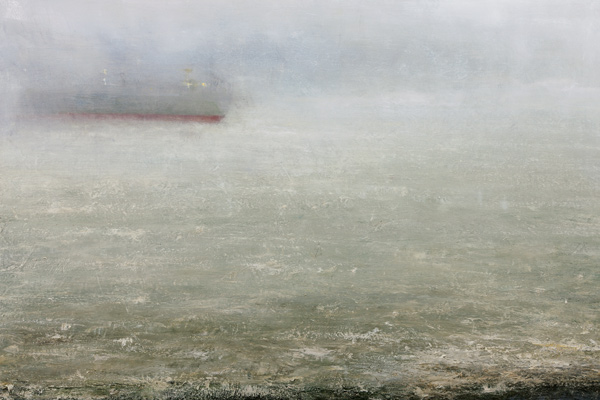Peter Archer used to paint landscapes on the Cornish side of the Tamar river. Their most notable features were lovingly observed trees and the tall chimneys of abandoned tin mines. One might have expected that when he moved to a coalmining valley in South Wales, his landscapes would have become blacker and its main features hills and slag-heaps. Instead, he has gone to sea, not literally nor even as an observer from some visited shore, but in his imagination. The Welsh coal-mines may have had something to do with it, since these are predominantly grey paintings in which, like Conrad’s Thames Estuary, ‘the air was dark above Gravesend, and farther back still seemed condensed into a mournful gloom, brooding motionless…’
Archer himself says that this subject crept up on him, ‘an impulse…increasingly forceful…a cuckoo in the nest…it had to be fed’, and that it met a need to escape from the more static, structural nature of his previous work. In effect these imagined scenes of foreshores and yeasty seas, their perspectives almost wiped out by veils of mist through which one can see a few spots of light or the vague shape of a ship or harbour-wall, are stories. They contain no plot nor — except in a single painting called ‘Bay’, where a small lone figure in a red jacket stands under a cliff on a shelf of slippery black granite — human characters. The protagonists are the artist himself and the viewer, and it is the emotional tension and silent exchange between them that constitute the narrative, its mood melancholy, its meaning elusive.
And although Archer has not been to look at the sea to find these scenes, he has certainly been to other painters, most obviously Turner and Whistler, as well as to Dickens’s Great Expectations and Arnold’s ‘Dover Beach’, for precedent and inspiration.
Literary reminiscences are, of course, only part of the meaning of these wholly visual mysteries. Whether laid on thinly in layers for the drifting atmosphere or thickly for foreshores and the choppy, greeny-blue, white-flecked sea, the painted surface provides the surprises and contrasts created by the careful deployment of words in a novel or poem.
In ‘Dark Cliffs, Wreck’, the hull of an abandoned steamer lies under a dense black cliff on a shore of purple pebbles, but at least half the canvas is invisibly misted sea and sky, the former reduced to a single streak of surf, the latter to an opaque struggle between light and dark, grey over white. In ‘Turning Vessel’, the mood and the palette is lighter, the long, deep foreground of creamy-green sea leading back to a blurred ship and barely detectable shoreline.
Archer’s ‘cuckoo’ has led him into a sombre yet hauntingly familiar place, somewhere between figuration and abstraction, between reality and fiction: the edge of our solid island, from which we peer into the ominously unstable elements of ocean and atmosphere that surround us.






Comments